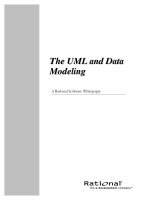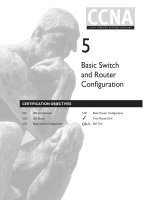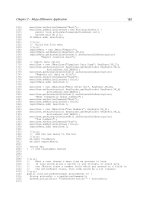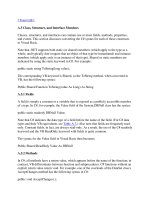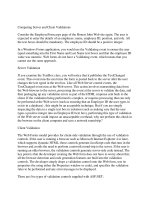Tài liệu THE NETWORKING AND INFORMATION TECHNOLOGY RESEARCH AND DEVELOPMENT PROGRAM doc
Bạn đang xem bản rút gọn của tài liệu. Xem và tải ngay bản đầy đủ của tài liệu tại đây (555.05 KB, 80 trang )
THE NETWORKING AND
INFORMATION TECHNOLOGY
RESEARCH AND DEVELOPMENT
PROGRAM
Supplement to the President’s Budget
FY 2013
FEBRUARY 2012
National Coordination Office (NCO) for
Networking and Information Technology Research and Development (NITRD)
George O. Strawn, Ph.D.
Director
Joan M. Stanley
Editor
Mark A. Luker, Ph.D.
Associate Director
Diane R. Theiss
Budget Analyst
4201 Wilson Boulevard, Suite II-405
Arlington, Virginia 22230
(703) 292-4873
Acknowledgements
This Supplement to the President’s Budget was developed through the contributions of the NITRD Federal
agency representatives and members, the NCO staff, and other Federal agencies involved in the NITRD
Program. We extend our sincere thanks and appreciation to all who have contributed.
National Coordination Office for Networking and Information Technology
Research and Development
The annual NITRD Supplement to the President’s Budget is prepared and published by the National
Coordination Office for Networking and Information Technology Research and Development (NCO/NITRD).
The NCO/NITRD supports overall planning, budget, and assessment activities for the multiagency NITRD
enterprise under the auspices of the NITRD Subcommittee of the National Science and Technology Council’s
(NSTC) Committee on Technology.
About the Document
This document is a supplement to the President’s 2013 Budget Request. It describes the activities underway in
2012 and planned for 2013 by the Federal agencies participating in the NITRD Program, primarily from a
programmatic and budgetary perspective. It reports actual investments for 2011, estimated investments for
2012 and requested investments for 2013 by Program Component Area (PCA). It identifies the NITRD
Program’s strategic priorities by PCA for budgetary requests; strategic priorities underlying the requests;
highlights of the requests; planning and coordination activities supporting the request; and 2012 and 2013
activities by agency.
Copyright Information
This is a work of the U.S. Government and is in the public domain. It may be freely distributed, copied, and
translated; acknowledgement of publication by the NCO/NITRD is appreciated. Any translation should include
a disclaimer that the accuracy of the translation is the responsibility of the translator and not the NCO/NITRD.
It is requested that a copy of any translation be sent to the NCO/NITRD.
Electronic versions of NITRD documents are available on the NCO Web site: .
Supplement to the President’s Budget
for Fiscal Year 2013
THE NETWORKING AND
INFORMATION TECHNOLOGY RESEARCH
AND DEVELOPMENT PROGRAM
A Report by the
Subcommittee on Networking and Information Technology
Research and Development
Committee on Technology
National Science and Technology Council
FEBRUARY 2012
National Science and Technology Council Committee on Technology
Tom Power, Chair, OSTP
*
Pedro Espina, Executive Secretary, OSTP
Subcommittee on Networking and Information Technology
Research and Development Co-Chairs
Farnam Jahanian, NSF
George O. Strawn, NCO
Department of Commerce
NIST
Representative
Charles H. Romine
Alternate
Kamie Roberts
NOAA
Representative
David Michaud
Alternate
Michael Kane
Department of Defense
DARPA
Representative
Charles J. Holland
NSA
Representative
Deborah A. Frincke
Alternate
Candace S. Culhane
OSD AND DOD
S
ERVICE RESEARCH ORGS.
Representative
Robert Gold
Alternates
Dai H. Kim
Air Force
Representative
Lt. Col. Dan Ward
Army
Representative
Marilyn Freeman
Alternate
Robert Saunders
Navy
Representative
Kam Ng
Department of Energy
DOE/NNSA
Representative
Robert Meisner
Alternate
Thuc T. Hoang
DOE/SC
Representative
Daniel A. Hitchcock
Alternate
William Harrod
Department of Health and
Human Services
AHRQ
Representative
J. Michael Fitzmaurice
Alternate
P. Jon White
NIH
Representative
Karin A. Remington
Alternates
Michael J. Ackerman
Karen Skinner
ONC
Representative
Douglas B. Fridsma
Independent Agencies
DHS
Representative
Douglas Maughan
Alternate
Luke Berndt
EPA
Representative
Gary L. Walter
NASA
Representative
Bryan A. Biegel
Alternate
James R. Fischer
NARA
Representative
Robert Chadduck
NSF
Representatives
Farnam Jahanian
Alan Blatecky
Alternate
Cynthia Dion-Schwarz
OMB
Representative
Arti Garg
OSTP
Acting Liaison
Pedro Espina
NCO/NITRD
Representative
George O. Strawn
Alternate
Mark Luker
* Formerly Aneesh Chopra
EXECUTIVE OFFICE OF THE PRESIDENT
NATIONAL SCIENCE AND TECHNOLOGY COUNCIL
WASHINGTON, D.C. 20502
February 15, 2012
Members of Congress:
I am pleased to transmit with this letter the FY 2013 annual report of the Federal
government’s multiagency Networking and Information Technology Research and Development
(NITRD) Program. The NITRD effort, which today comprises 15 member agencies and many
more that participate in NITRD activities, coordinates Federal research and development
investments in the advanced digital technologies essential for the Nation’s economic growth and
prosperity in the 21
st
century.
In less than a generation, networking and computing technologies have transformed our
individual lives as well as business, government, and education. The United States needs to
accelerate the flow of advances in cutting-edge digital technologies that drive economic
innovation and job growth, and provide next-generation capabilities for scientific discovery,
education, and national security. As the President has made clear, such networking and
computing capabilities will also provide critical foundations for a number of specific policy
priorities, including an improved health care system; more-efficient energy delivery systems and
discovery of renewable resources; and a more secure, privacy-protecting Internet.
The Federal NITRD investments we make today will be crucial to the creation of
tomorrow’s new industries and workforce opportunities. I look forward to continuing to work
with you to support this vital Federal program.
Sincerely,
John P. Holdren
Assistant to the President for Science and Technology
Director, Office of Science and Technology Policy
TABLE OF CONTENTS
Overview 1
1
1.1
NITRD Program Component Areas (PCAs) 1
1.2
Senior Steering Groups (SSGs) 6
1.3
Community of Practice (CoP) 7
Introduction 9
2
2.1
Program Component Areas (PCAs) 9
2.2
The NITRD Program 9
2.3
Senior Steering Groups (SSGs) 10
2.4
NITRD Member Agencies 10
2.5
NITRD Participating Agencies 11
Agency Investments in the NITRD PCAs 12
3
3.1
FY 2011 Budget Actuals (Dollars in Millions) 12
3.2
FY 2012 Budget Estimates (Dollars in Millions) 13
3.3
FY 2013 Budget Requests (Dollars in Millions) 13
3.4
NITRD Program Budget Analysis 14
3.5
NITRD Program Budget Analysis by Agency 14
3.6
NITRD Program Budget Analysis by PCA 15
Strategic Priorities for Budget Request by PCA 16
4
4.1
Cybersecurity and Information Assurance (CSIA) 16
4.2
High Confidence Software and Systems (HCSS) 23
4.3
High End Computing (HEC) Infrastructure and Applications (I&A) 28
4.4
High End Computing (HEC) Research and Development (R&D) 32
4.5
Human Computer Interaction and Information Management (HCI&IM) 35
4.6
Large Scale Networking (LSN) 39
4.7
Social, Economic, and Workforce Implications of IT and IT Workforce Development (SEW) 44
4.8
Software Design and Productivity (SDP) 48
Senior Steering Groups (SSGs) 52
5
5.1
Big Data Research and Development Senior Steering Group (BD R&D SSG) 52
5.2
Cybersecurity and Information Assurance Research and Development Senior Steering Group (CSIA
R&D SSG) 53
5.3
Health Information Technology Research and Development Senior Steering Group (HIT R&D SSG) 55
5.4
Wireless Spectrum Research and Development Senior Steering Group (WS R&D SSG) 57
Community of Practice (CoP) 59
6
6.1
Faster Administration of Science and Technology Education and Research (FASTER) Community of
Practice (CoP) 59
Membership in the NITRD Program 61
7
7.1
Benefits of NITRD Membership 61
7.2
Responsibilities of NITRD Membership 61
NITRD Program Component Area (PCA) Co-Chairs 62
8
NITRD Senior Steering Group (SSG) and Community of Practice (CoP) Co-Chairs 63
9
Abbreviations and Acronyms 64
NITRD SUPPLEMENT TO THE PRESIDENT’S FY 2013 BUDGET
1
Overview
1
The Networking and Information Technology Research and Development (NITRD) Program consists of a group
of Federal agencies working together to research and develop a broad spectrum of advanced information
technology (IT) capabilities to empower Federal missions; support U.S. science, engineering, and technology
leadership; and bolster U.S. economic competiveness. The interagency program focuses on identifying
research that will help the United States to “out-innovate, out-educate, and out-build the rest of the world.”
1
NITRD Program activities are reported under a set of eight Program Component Areas (PCAs), four Senior
Steering Groups (SSGs), and a Community of Practice (CoP). The NITRD Subcommittee convenes three times a
year and the working groups meet approximately 12 times annually and provide input to the NITRD
Supplement to the President’s Budget.
1.1
NITRD Program Component Areas (PCAs)
The following is an overview of the eight NITRD PCAs strategic priorities. These PCAs cover the range of
Federal networking and information technology R&D. Thus, NITRD working groups are organized around
these PCAs, and NITRD investments by agencies are reported by PCA in NITRD Budget Supplements.
1.1.1 Cybersecurity and Information Assurance (CSIA)
CSIA priorities are organized into four thrusts according to the 2011 Federal Cybersecurity R&D Strategic Plan,
2
“Inducing Change, Developing Scientific Foundations, Maximizing Research Impact, and Accelerating
Transition to Practice.” These thrusts provide a framework for prioritizing cybersecurity research and
development that focuses on limiting current cyberspace deficiencies, precluding future problems, and
expediting the infusion of research accomplishments into the marketplace. The principal objectives include
achieving greater cyberspace resiliency to attacks, and enhancing our capabilities to design software that is
resistant to attacks.
Inducing Change: Utilize game-changing themes to analyze the underlying root causes of known
current threats to disrupt the status quo with radically different approaches that improve the security
of the critical cyber systems and infrastructure that serve society.
Developing Scientific Foundations: Develop an organized, cohesive scientific foundation to serve
as the cornerstone for cybersecurity by establishing a systematic, rigorous, and disciplined scientific
approach that will promote the discovery of laws, hypothesis testing, repeatable experimental
designs, standardized data-gathering methods, metrics, common terminology, and critical analysis
that engenders reproducible results and rationally based conclusions.
Maximizing Research Impact: Catalyze integration across the game-changing research and
development themes, cooperation between governmental and private-sector communities,
collaboration across international borders, and strengthened linkages to other national priorities,
such as health IT and Smart Grid.
1
“A Strategy for American Innovation: Securing Our Economic Growth and Prosperity,” President Barack Obama, February 4, 2011
(
2
Released December 2011
(
NITRD SUPPLEMENT TO THE PRESIDENT’S FY 2013 BUDGET
2
Accelerating Transition to Practice: Implement powerful new technologies and strategies that
emerge from the research themes and from the activities to build a scientific foundation so as to
create measurable improvements in the cybersecurity landscape.
1.1.2 High-Confidence Software and Systems (HCSS)
In recent years, the HCSS agencies have engaged in a sustained effort to foster a new multidisciplinary
research agenda that will enable the United States to lead in the development of next-generation engineered
systems that depend on ubiquitous cyber control and require very high levels of system assurance. Through a
variety of ongoing activities, the HCSS effort is forging a nationwide community interested in the Cyber-
Physical Systems (CPS) research challenges faced in common across such economic sectors as medicine and
health care, energy, transportation, manufacturing, and agriculture, and across such agency missions as
national security, environmental protection, and space exploration. The HCSS agencies have set the following
priorities for research coordination:
Science and technology for building cyber-physical systems (CPS): Develop a new systems
science providing unified foundations, models and tools, system capabilities, and architectures that
enable innovation in highly dependable cyber-enabled engineered and natural systems
Management of complex and autonomous systems: Develop measurement and understanding
for improved models of complex systems of systems, shared control and authority, levels of
autonomy, and human-system interactions, and new integrated analytical, and decision-support
tools
Assurance technology: Develop a sound scientific and technological basis, including formal
methods and computational frameworks, for assured design, construction, analysis, evaluation, and
implementation of reliable, robust, safe, secure, stable, and certifiably dependable systems regardless
of size, scale, complexity, and heterogeneity; develop software and system engineering tool
capabilities to achieve application and problem domain-based assurance, and broadly embed these
capabilities within the system engineering process; reduce the effort, time, and cost of assurance
(“affordable” verification and validation [V&V]/certification); provide a technology base of advanced-
prototype implementations of high-confidence technologies to spur adoption
High-confidence real-time software and systems: Pursue innovative design, development, and
engineering approaches to ensure the dependability, safety, security, performance, and evolution of
software-intensive, dynamic, networked control systems in life- and safety-critical infrastructure
domains, including systems-of-systems environments; real-time embedded applications and systems
software; component-based accelerated design and verifiable system integration; predictable,
fault-tolerant, distributed software and systems
Translation into mission-oriented research: Leverage multi-agency research to move theory into
practice, for example, through challenge problems
CPS education: Launch an initiative to integrate CPS theory and methodology into education and
promote increased understanding of and interest in CPS through the development of new curricula
at all levels to break down the silos between physical and cyber disciplines and evolve a new
generation of U.S. experts
1.1.3 High-End Computing Infrastructure and Applications (HEC I&A)
High-fidelity modeling and simulation and large-scale data analysis, enabled by HEC, have become essential
and powerful tools for advancing science, technology, and other National priorities and Federal agency
missions. The HEC infrastructure enable researchers in academia, Federal laboratories, and industry to model
and simulate complex processes in aerospace, astronomy, biology, biomedical science, chemistry, climate and
weather, energy and environmental sciences, high energy physics, materials science, nanoscale science and
technology, national security, and other areas to address Federal agency mission needs. Priorities include:
NITRD SUPPLEMENT TO THE PRESIDENT’S FY 2013 BUDGET
3
Advancement of HEC applications: Support the development of scientific and engineering
applications software for current and next-generation HEC platforms; develop mission-responsive
computational environments; and lead critical applied mathematics research
Leading-edge cyber infrastructure: Provide efficient access to HEC facilities and resources, enhance
infrastructure for computational and data-enabled science, and share best practices for
cost-effectively and energy efficiently managing and enhancing HEC resources
Leadership-class and production quality HEC systems: Acquire and operate the highest capability
and capacity HEC systems to meet critical agency needs and to support the national science and
engineering communities
1.1.4 High-End Computing Research and Development (HEC R&D)
After decades of exponential increase in computing power per dollar, the HEC community faces great
challenges in creating the hardware, software, and systems to achieve and exploit the next few orders of
magnitude increase in HEC capability expected by 2020. These challenges include developing applications
and system architectures that effectively utilize billion-fold concurrency, reducing the energy per
computation by orders of magnitude, achieving system resilience at extreme scales, and enabling future
revolutions in simulation and big-data-enabled science and technology. To remain leaders in their mission
areas, and to maintain U.S. leadership in HEC technology, Federal agencies will lead the R&D to overcome
these challenges. In view of these challenges, the HEC R&D agencies see the following as research priorities
for FY 2013:
Extreme-scale computation: Integrate computer science and applied mathematical foundations to
address the challenges of achieving productive and efficient computation at the exascale level and
beyond. Develop innovative systems that combine increased speed, economic viability, high
productivity, and robustness to meet future agency needs for systems that manage ultra-large
volumes of data and run multi-scale, multidisciplinary science and engineering simulations. Explore
new concepts and approaches for solving technical challenges such as power use, thermal
management, file system input/output (I/O) latency, resiliency, highly parallel system architectures,
and programming language and development environments that can increase the usability of
large-scale multiprocessor (including hybrid) systems. Develop, test, and evaluate prototype HEC
systems and software to reduce industry and end-user risk and to increase competitiveness.
New directions in HEC hardware, software and system architectures: Develop novel scientific
frameworks, system architectures, and prototypes to take computing power and communications
“beyond Moore’s Law;” advance quantum computing.
Productivity: Continue collaborative development of new metrics of system performance, including
benchmarking, lessons learned for acquisition, and total ownership costs of HEC systems; integrate
resources for improved productivity. Design and develop requirements for software to enable,
support, and increase the productivity of geographically dispersed collaborative teams that develop
future HEC applications.
1.1.5 Human-Computer Interaction and Information Management (HCI&IM)
The Federal Government generates and maintains the world’s largest digital collections of science and
engineering data, historical records, health information, and scientific and other types of archival literature.
Making R&D that is enabled by large data sets a science and technology priority will contribute to U.S.
economic growth and technological innovation. New research and advances are needed in:
Information integration:
o Standards provide a way for data to be brought together with shared meaning, providing the
basis for interoperability and relationship building which is a basic step of integrating and
managing data.
NITRD SUPPLEMENT TO THE PRESIDENT’S FY 2013 BUDGET
4
o Decision-support systems provide mechanisms for sifting through large, complex data sets to
identify alternative strategies from the data that, without computational analysis, would strain
human cognitive capabilities.
o Information management systems enable individuals and organizations to create, share, and
apply information to gain value and achieve specific objectives and priorities.
Information infrastructure: A robust, resilient national digital data framework for long-term
preservation and accessibility of electronic records as well as expanding data and records collections
Active systems: This research will provide novel insights into how IT systems can learn, reason, and
automatically adapt to new and unforeseen events. Examples include cognitive robotics, in which a
mobile manipulator could deploy a specific model of the user’s mind to increase the effectiveness of
interactions.
Multimodal systems: These systems provide ways for human users to expand their cognitive reach
and performance when faced with large, complex data. These can be activated by speech, or other
human senses, or movement, sounds, etc. These mechanisms provide different interactions that
reflect user requirements.
1.1.6 Large-Scale Networking (LSN)
LSN Federal agencies coordinate networking R&D in future Internet architectures, optical and wired networks,
enabling end-to-end applications, network management, R&D for complex networks, identity management,
cloud computing, and wireless technology.
Measurement, management, and control of large-scale distributed infrastructures: Including
networks, applications, management/control, sensors and their placement, metrics (supported by
measurement technologies), and complex systems modeling and analysis in this endeavor.
Operational capabilities: Identify approaches and promote implementation of best practices for
identity management, Internet Protocol version 6 (IPv6), cloud computing, and campus interfaces
and architectures for large data flows. Promote cooperation among network testbeds including
Global Environment for Networking Innovations (GENI) Advanced Networking Initiatives (ANI),
Magellan Phase 2 and others
Dynamic optical networking: Identify, in coordination with the research community, the status,
technology, research needs, and best practices. Identify next steps for development, and
deployment.
1.1.7 Social, Economic, and Workforce Implications of IT and IT Workforce
Development(SEW)
Research activities funded under the SEW PCA focus on the co-evolution of IT and social, economic, and
workforce systems including interactions between people and IT and among people developing and using IT
in groups, organizations, and larger social networks. Key focus areas include:
Science of collaboration
o IT-enabled innovation ecology: Shape the creation of IT and research on IT-enabled
collaboration in ways that improve the conduct of science and engineering now and in the future
and revitalize American leadership in R&D
o Integrated multidisciplinary research: Support research, development, and education that
address societal challenges using a systems-based approach to understand, predict, and react to
changes in the linked natural, social, and man-made environment – especially in climate change,
energy, health, education, and security
o Humans in the loop: Advance understanding of complex and increasingly coupled relationships
between people and computing, with an emphasis on IT designed to fit the needs of its users,
NITRD SUPPLEMENT TO THE PRESIDENT’S FY 2013 BUDGET
5
and enable explorations of creative ideas, novel theories, and innovative technologies that
promise to transform the way humans communicate, work, learn, play, and maintain their health
IT and education
o Cyber-learning: Promote understanding and support for effective IT-enabled learning in all
education settings to enhance learning anytime in any location, and provide learning
personalized and tailored to the needs of diverse learners; transform science teaching across
education and settings
o Computational competencies for everyone: Explore how the nature and meaning of
computational competence can be incorporated into K-12, informal, and higher education
o IT education and training: Develop innovative approaches to broadening interest and
participation in 21st Century IT careers, including information assurance and computer security
1.1.8 Software Design and Productivity (SDP)
Complex software-based systems today power the Nation’s most advanced defense, security, and economic
capabilities. Such systems also play central roles in science and engineering discovery, and thus are essential
in addressing this century’s grand challenges (e.g., low-cost, carbon-neutral, and renewable energy; clean
water; next-generation health care; extreme manufacturing; space exploration, etc.). These large-scale systems
typically must remain operational, useful, and relevant for decades. The involved agencies are working to
identify and define the core elements for a new science of software development that will make engineering
decisions and modifications transparent and traceable throughout the software lifecycle (e.g., design,
development, evolution, and sustainment). A key goal of this science framework is to enable software
engineers to maintain and evolve complex systems cost-effectively and correctly long after the original
developers have departed. The following areas are research priorities:
Research to rethink software design: From the basic concepts of design, evolution, and adaptation
to advanced systems that seamlessly integrate human and computational capabilities, including:
o Foundational/core research on science and engineering of software: Develop new
computational models and logics, techniques, languages, tools, metrics, and processes for
developing and analyzing software for complex software-intensive systems (e.g., a fundamental
approach to software engineering that can provide systems that are verifiably correct, assured,
efficient, effective, reliable, and sustainable)
o Next-generation software concepts, methods, and tools: Reformulate the development
process, the tool chain, the partitioning of tasks and resources; open technology development
(open-source and open-systems methods); technology from nontraditional sources;
multidisciplinary and cross-cutting concepts and approaches; next-generation software concepts,
methods, and tools will be needed for emerging technologies such as multicore, software-as-a-
service, cloud computing, end-user programming, quantum information processing; modeling of
human-machine systems
o Capabilities for building evolvable, sustainable, long-lived software-intensive systems:
Explore new means to create, keep current, and use engineering artifacts to support long-lived
software-intensive systems; new approaches to reliably meet changing requirements and assure
security and safety; long-term retention and archiving of software-development data and
institutional knowledge
Predictable, timely, cost-effective development of software-intensive systems: Disciplined
methods, technologies, and tools for systems and software engineering, rapidly evaluating
alternative solutions to address evolving needs; measuring, predicting, and controlling software
properties and tradeoffs; virtualized and model-based development environments; automation of
deterministic engineering tasks; scalable analysis, test generation, optimization, and verification with
traceability to requirements; related issues:
NITRD SUPPLEMENT TO THE PRESIDENT’S FY 2013 BUDGET
6
o Software application interoperability and usability: Develop interface and integration
standards, representation methods to enable software interoperability, data exchanges,
interoperable databases; supply-chain system integration; standardized software engineering
practices for model development
o Cost and productivity issues in development of safety-critical, embedded, and autonomous
systems: Research on composition, reuse, power tools, training, and education to address
systems that can be inaccessible after deployment (e.g., spacecraft) and need to operate
autonomously
1.2 Senior Steering Groups (SSGs)
The following is an overview of NITRD’s established Senior Steering Groups (SSGs). The SSGs are formed to
focus on emerging issues and are not required to report budgetary information to the NITRD program. They
offer an additional means for agency collaboration for individuals, who because of their level of authority, who
typically do not participate in the PCAs.
1.2.1 Big Data Research and Development Senior Steering Group (BD R&D SSG)
The BD R&D SSG was formed in early 2011 to identify current big data research and development activities
across the Federal government, offer opportunities for coordination, and identify the goals of a potential
national initiative in this area. The BD R&D SSG strategic priorities include the following:
Promote new science, address key science questions, and accelerate the process of discovery by
harnessing the value of large, heterogeneous data
Exploit the unique value of big data to address areas of national need, agency missions, and societal
and economic importance
Support responsible stewardship and sustainability of data resulting from federally funded research
Develop and sustain the infrastructure needed to advance data science and broaden the
participation in data-enabled inquiry and data-driven action, at all levels
1.2.2 Cybersecurity and Information Assurance Research and Development
Senior Steering Group (CSIA R&D SSG)
The purpose of the CSIA R&D SSG is to provide overall leadership for cybersecurity research and development
coordination, to address the need for streamlined decision processes and dynamic responsiveness to
changing research and budget priorities. The CSIA R&D SG’s strategic priorities include:
Prioritize Federal cybersecurity research and development investments and ensure that the entire
spectrum of research and development priorities and technology challenges across the Federal
government are being addressed
Lead strategic research and development coordination efforts in addressing the Administration
priorities (such as the President’s Cyberspace Policy Review)
Formulate and evolve a framework for research and development strategies that focuses on game-
changing technologies
1.2.3 Health Information Technology Research and Development
Senior Steering Group (HIT R&D SSG)
The HIT R&D SSG was established in the fall of 2010 in response to Section 13202(b) of the American Recovery
and Reinvestment Act of 2009 (ARRA, P.L. 111-5) which directed the NITRD Program to include Federal
research and development programs related to health information technology.
The HIT R&D SSG established the Health Information Technology Innovation and Development Environments
(HITIDE) Subgroup. The aim of the HITIDE Subgroup is to advance the development of interoperable health IT
NITRD SUPPLEMENT TO THE PRESIDENT’S FY 2013 BUDGET
7
systems by leveraging the existing testbed environments of Federal agency health IT systems for a virtual test,
development, and innovation ecosystem.
The HITIDE Subgroup focuses on governance challenges, operational opportunities, and issues relevant to
HITIDE projects. Its current interests include interoperability, standards, de-identified test data, and
organizational barriers. Briefings held in 2011 on these topics included: lessons learned in establishing
development test centers (DoD/Military Health System [MHS]); using synthetic data as test data
(DoD/Telemedicine and Advanced Technology Research Center [TATRC]); identifying content resources and
tools available to developers (National Library of Medicine [NLM]); identifying issues and challenges with
medical device interoperability (NIH Affiliate, ONC Strategic Health IT Advanced Research Projects [SHARP]
program); and developing substitutable, modular applications for health IT systems (ONC SHARP program).
The strategic priorities of the HIT R&D SSG and the HITIDE Subgroup include the following:
Address multiagency leadership in health IT interoperability and the development of innovative
applications
Bring together health and research and development IT communities to focus on health IT research
and development needs
1.2.4 Wireless Spectrum Research and Development Senior Steering Group (WS R&D SSG)
The WS R&D SSG was established in 2010 in response to the June 28, 2010 Presidential Memorandum –
Unleashing the Wireless Broadband Revolution.
3
The memorandum calls for NITRD to assist the Secretary of
Commerce in creating and implementing a plan to facilitate research, development, experimentation, and
testing by researchers to explore innovative spectrum-sharing technologies. The WS R&D SSG priorities are
guided by the following strategic objectives:
Transparency: Communicate to both Federal agencies and the private sector the research and
development activities currently being pursued or planned, and help identify areas that still need to
be addressed
Smart investment: Develop strategies that can supplement funding for research and development
and/or increase the efficiency of existing investments
Solicit opportunities: Identify opportunities for spectrum technology transfer between Federal
agencies and the private sector
1.3 Community of Practice (CoP)
1.3.1 Faster Administration of Science and Technology Education and Research (FASTER)
Community of Practice (CoP)
FASTER, supported by the NITRD NCO, communicates with the White House Office of Management and
Budget (OMB) and the Federal Chief Information Officers (CIO) Council concerning IT R&D matters that are of
general interest to Federal agencies. FASTER’s goal is to enhance collaboration and accelerate agencies’
adoption of advanced IT capabilities developed by Government-sponsored IT research. The group is focused
on the following strategic themes:
Cloud computing
Semantic web and ontology technology
Open government
3
Section 3.
NITRD SUPPLEMENT TO THE PRESIDENT’S FY 2013 BUDGET
8
Emerging technologies
Sharing knowledge, ideas, and best practices
NITRD SUPPLEMENT TO THE PRESIDENT’S FY 2013 BUDGET
9
Introduction
2
Now in its 21st year, NITRD is the oldest and largest of the small number of formal Federal programs that
engage multiple agencies. As required by the High-Performance Computing Act of 1991 (P.L. 102-194), the
Next Generation Internet Research Act of 1998 (P.L. 105-305), and the America COMPETES (Creating
Opportunities to Meaningfully Promote Excellence in Technology, Education, and Science) Act of 2007 (P.L.
110-69), NITRD currently provides a framework and mechanisms for coordination among 15 Federal agencies
that support advanced IT R&D and report IT research budgets in the NITRD crosscut. Many other agencies with
IT interests also participate informally in NITRD activities.
2.1
Program Component Areas (PCAs)
The agencies coordinate their NITRD activities and plans in the following Program Component Areas (PCAs).
The PCAs are identified as an Interagency Working Group (IWG) or a Coordinating Group (CG) and report their
R&D budgets as a crosscut of the NITRD agencies. They are charged with facilitating interagency program
planning, developing and periodically updating interagency roadmaps, developing recommendations for
establishing Federal policies and priorities, summarizing annual activities for the NITRD program's
Supplement to the President's Budget, and identifying potential opportunities for collaboration which has
been identified by OMB and the White House Office of Science and Technology Policy (OSTP) as priorities for
Federal coordination and collaboration. The PCAs are listed in Table 1.
Cybersecurity and Information Assurance (CSIA)
High-Confidence Software and Systems (HCSS)
High-End Computing Infrastructure and Applications (HEC I&A)
High-End Computing Research and Development (HEC R&D)
Human-Computer Interaction and Information Management (HCI&IM)
Large-Scale Networking (LSN)
Social, Economic, and Workforce Implications of IT and IT Workforce Development (SEW)
Software Design and Productivity (SDP)
Table 1. PCAs
2.2
The NITRD Program
The Networking and Information Technology Research and Development (NITRD) Program is the Nation's
primary source of Federally funded work on advanced information technologies such as computing,
networking, and software.
A unique collaboration of Federal research and development agencies, the NITRD Program seeks to:
Provide research and development foundations for assuring continued U.S. technological leadership
in advanced networking, computing systems, software, and associated information technologies
Provide research and development foundations for meeting the needs of the Federal government for
advanced networking, computing systems, software, and associated information technologies
Accelerate development and deployment of these technologies in order to maintain world
leadership in science and engineering; enhance national defense and national and homeland
security; improve U.S. productivity and competitiveness and promote long-term economic growth;
improve the health of the U.S. citizenry; protect the environment; improve education, training, and
lifelong learning; and improve the quality of life
NITRD SUPPLEMENT TO THE PRESIDENT’S FY 2013 BUDGET
10
2.3 Senior Steering Groups (SSGs)
In addition to the PCAs, NITRD has established several Senior Steering Groups (SSGs). The SSGs allow a more
flexible model for NITRD collaboration and are formed to focus on emerging issues as required by a mandate
from OSTP. SSGs do not report an R&D budget under NITRD. The following SSG R&D domains are currently
under the NITRD umbrella:
Big Data R&D SSG
Cybersecurity and Information Assurance R&D SSG
Health Information Technology R&D SSG
Wireless Spectrum R&D SSG
Table 2. SSGs
For further information about the NITRD Program, please visit the NITRD web site: www.nitrd.gov
2.4 NITRD Member Agencies
The following Federal agencies, which conduct or support R&D in advanced networking and information
technologies, report their IT research budgets in the NITRD crosscut and provide proportional funding to
support the NITRD/NCO operations:
Department of Commerce (DOC)
National Institute of Standards and Technology (NIST)
National Oceanic and Atmospheric Administration (NOAA)
Department of Defense (DoD)
Defense Advanced Research Projects Agency (DARPA)
National Security Agency (NSA)
Office of the Secretary of Defense (OSD) and Service Research Organizations
o Air Force Office of Scientific Research (AFOSR)
o Air Force Research Laboratory (AFRL)
o Army Research Laboratory (ARL)
o Office of Naval Research (ONR)
Department of Energy (DOE)
National Nuclear Security Administration (DOE/NNSA)
Office of Science (DOE/SC)
Department of Homeland Security (DHS)
Department of Health and Human Services (HHS)
Agency for Healthcare Research and Quality (AHRQ)
National Institutes of Health (NIH)
Office of the National Coordinator for Health Information Technology (ONC)
Environmental Protection Agency (EPA)
National Aeronautics and Space Administration (NASA)
National Archives and Records Administration (NARA)
National Science Foundation (NSF)
Table 3. NITRD Member Agencies
NITRD SUPPLEMENT TO THE PRESIDENT’S FY 2013 BUDGET
11
2.5 NITRD Participating Agencies
Representatives of the following agencies with mission interests involving networking and IT R&D
and applications are active participants in NITRD activities:
Department of Commerce (DOC)
National Telecommunications and Information Administration (NTIA)
Department of Defense (DoD)
Defense Information Systems Agency (DISA)
Intelligence Advanced Research Projects Agency (IARPA)
Department of Energy (DOE)
Office of Electricity Delivery and Energy Reliability (DOE/OE)
Department of Health and Human Services (HHS)
Centers for Disease Control and Prevention (CDC)
Food and Drug Administration (FDA)
Indian Health Service (IHS)
Office of the Assistant Secretary for Preparedness and Response (ASPR)
Department of Interior (Interior)
U.S. Geological Survey (USGS)
Department of Justice (DOJ)
Federal Bureau of Investigation (FBI)
Department of State (State)
Department of Transportation (DOT)
Federal Aviation Administration (FAA)
Federal Highway Administration (FHWA)
Department of the Treasury (Treasury)
General Services Administration (GSA)
National Transportation Safety Board (NTSB)
Nuclear Regulatory Commission (NRC)
U.S. Department of Agriculture (USDA)
Department of Veterans Affairs (VA)
Table 4. NITRD Participating Agencies
T
h
b
T
s
y
N
o
r
t
f
3
T
he yearly Su
h
igh-level su
m
b
udget cycle
,
T
he NITRD S
u
s
ection, orga
n
y
ear to year.
N
ITRD agenc
i
o
rder, follow
e
r
ather than f
u
t
hey involve
R
f
unding in ea
3
.1
FY
2
Agen
c
NS
F
Do
D
NI
H
DO
E
DAR
P
NIS
T
NAS
A
DH
S
AH
R
NO
A
DOE/N
N
EP
A
NA
R
DO
T
Total 2011
1
T
otals may n
o
2
DoD budget i
3
DOE budget i
Acceleration
F
NITR
D
A
ge
3
pplement to
m
mary of th
e
,
as required
u
pplement in
n
ized by PC
A
i
es engaged
e
d by the pa
r
u
nders or pe
r
R
&D efforts i
n
ch relevant
P
2
011 Bud
c
y
F
D
2
H
E
3
P
A
T
A
S
R
Q
A
A
N
SA
A
R
A
T
Actuals
1
o
t sum correctly
ncludes fundin
g
n
cludes fundin
g
F
und
D
SUPPLE
M
n
cy In
v
the Preside
n
e
research ac
t
by law.
cludes an an
A
and by age
n
i
n R&D and c
r
ticipating a
g
r
formers. So
m
n
a variety of
P
CA.
get Actu
a
HEC
I&A
H
E
R
&
357.0 1
0
274.0 3
221.0 1
310.1 8
8
14.0
62.6
20.9
10.0 1
3.0
1
,272.6 33
T
due to roundin
g
from OSD, NS
A
g
from DOE's O
f
M
ENT TO
T
v
estme
n
n
t’s Budget f
o
t
ivities plann
nual budget
n
cy, to facilit
a
oordination
a
g
encies. Age
n
m
e large-scal
e
technologie
s
a
ls (Dolla
r
E
C
&
D
CSIA
0
3.4 76.5
2.0 141.4
8.0
1.5 33.5
0.0 127.0
7.3 25.7
41.0
0.2
5.0
7.4 445.1
T
able 5. FY
2
g
A
, and the DoD
f
fices of Science
,
T
HE PRESI
D
12
n
ts in
t
o
r the NITRD
ed and coor
d
table, a req
u
a
te budgetar
y
a
ctivities cit
e
n
cies listed a
f
e
activities
m
s
. In such ca
s
r
s in Milli
o
HCI
&IM
283.3
95.0
215.0
156.0
15.0
14.9
27.1
0.5
3.0
2.0
811.8
2
011 Budge
t
service researc
h
,
Electricity Deli
v
D
ENT’S FY
2
t
he NI
T
Program is
d
d
inated thro
u
u
ested budg
e
y and progr
a
e
d in the Sup
f
ter the word
m
ay be cited i
n
s
es, agencies
o
ns)
LSN
HC
S
128.1 7
142.4 4
12.0 1
0
49.8
73.0
5.0
0.8 1
0
3.0
0.5
4.0
1.0
4
419.6 15
0
t Actuals
h
organizations
v
ery and Energ
y
2
013 BUDG
T
RD
P
d
esigned to
p
u
gh NITRD i
n
e
t table, and
a
a
mmatic co
m
plement are
“with” are i
n
n
more than
report the p
o
S
S
SDP
8.0 54.7
1.8 23.3
0.0 53.0
1.3 7.0
5.5 5.2
0.2 5.8
3.0
0.7
4
.0
0.8 152.7
y
Reliability, an
d
ET
P
CAs
p
resent a suc
c
n
a given Fed
a
budget an
a
m
parisons fro
m
listed in alp
h
n
-kind contri
b
one PCA be
c
o
rtion of pro
g
SEW
T
108.4
1
22.0
6.0
0.6
137.0
3
d
Energy Transf
o
c
inct,
eral
a
lysis
m
h
abetic
b
utors
c
ause
gram
T
otal
1
,189.4
749.9
551.0
489.2
436.0
78.3
94.3
47.0
27.6
26.3
30.0
6.0
2.0
0.0
3
,727.0
o
rmation
NITRD SUPPLEMENT TO THE PRESIDENT’S FY 2013 BUDGET
13
3.2 FY 2012 Budget Estimates (Dollars in Millions)
Agency
HEC
I&A
HEC
R&D
CSIA
HCI
&IM
LSN HCSS SDP SEW Total
1
NSF
250.0 103.0 98.5 292.0 121.8 84.7 78.3 110.2
1,138.3
DoD
2
211.1 49.0 144.6 111.3 111.7 36.4 30.0
694.1
NIH
222.0 18.0 215.0 12.0 10.0 54.0 22.0
553.0
DOE
3
316.8 92.4 33.5 73.8 4.0 16.0 6.0
542.5
DARPA
75.0 223.0 138.0 53.0
489.0
NIST
14.3 5.0 47.2 15.0 8.1 5.8 4.4 0.4
100.2
NASA
61.2 13.8 0.8 17.5 9.4
102.6
DHS
43.0 1.0 3.0
47.0
AHRQ
25.1 0.5
25.6
NOAA
19.4 1.9 0.7
22.0
DOE/NNSA
9.0 5.0 4.0
18.0
EPA
3.0 3.0
6.0
NARA
1.0
1.0
DOT
0.0
Total 2012 Estimates 1,106.7 347.4 589.8 814.2 384.5 158.4 195.8 142.6 3,739.4
Table 6. FY 2012 Budget Estimates
3.3 FY 2013 Budget Requests (Dollars in Millions)
Agency
HEC
I&A
HEC
R&D
CSIA
HCI
&IM
LSN HCSS SDP SEW Total
1
NSF
255.6 109.9 114.1 297.2 131.4 97.6 83.7 117.7
1,207.2
DoD
2
196.2 27.4 156.6 107.8 105.3 35.5 25.3
654.0
NIH
221.0 18.0 215.0 12.0 10.0 53.0 22.0
551.0
DOE
3
328.3 92.1 33.5 82.6 6.0 20.0 6.0
568.5
DARPA
79.0 247.0 87.0 49.0
462.0
NIST
16.0 5.0 55.2 15.8 12.1 7.8 4.4 0.4
116.7
NASA
60.0 13.0 1.0 16.8 9.6
100.4
DHS
61.0 3.0
64.0
AHRQ
25.1 0.5
25.6
NOAA
20.6 0.2 0.5 3.6 0.7
25.6
DOE/NNSA
10.0 11.0 4.0
25.0
EPA
3.0 3.0
6.0
NARA
1.0
1.0
DOT
1.0
1.0
Total 2013 Requests 1,110.7 342.5 667.4 765.4 400.5 174.7 196.6 150.1 3,807.9
Table 7. FY 2013 Budget Requests
1
Totals may not sum correctly due to rounding
2
DoD budget includes funding from OSD, NSA, and the DoD service research organizations
3
DOE budget includes funding from DOE's Offices of Science, Electricity Delivery and Energy Reliability, and Energy Transformation
Acceleration Fund
NITRD SUPPLEMENT TO THE PRESIDENT’S FY 2013 BUDGET
14
3.4 NITRD Program Budget Analysis
Fiscal Year Overview for 2012-2013
Differences between the President’s Budget request for a given year and estimated spending for that year
reflect revisions to program budgets due to evolving priorities, as well as Congressional actions and
appropriations. In addition, the NITRD agencies have continued to work collectively on improving the PCA
definitions, as reflected by changes in the definitions outlined in OMB Circular A-11, and individually on
improving the classification of investments within the PCAs, resulting in changes in NITRD Program budgets.
Summary
The President’s 2013 budget request for the NITRD Program is $3.808 billion, an increase of $69 million,
approximately 1.85 percent, more than the $3.739 billion 2012 estimate. The overall change is due to both
increases and decreases in individual agency NITRD budgets, which are described below.
3.5 NITRD Program Budget Analysis by Agency
This section describes changes greater than $10 million between 2012 estimated spending and 2013 requests.
Smaller changes are discussed only if they represent shifts in funding focus. Budget numbers in these
descriptions are rounded from initial agency numbers with three decimals to the nearest whole number.
3.5.1 NSF
Comparison of 2012 estimate ($1,138 million) and 2013 request ($1,207 million): The increase of $69 million is
primarily due to $15 million in CSIA for enhanced support for Secure and Trustworthy Cyberspace (SaTC); $9
million in LSN for additional funding for research in new wireless communications and spectrum sharing
architectures and services as part of EARS and a slight decrease due to termination of the Network Science and
Engineering (NetSE) cross-cutting program; $13 million in HCSS for Cyber-Physical Systems and the National
Robotics Initiative, both of which are part of the CEMMSS effort; and smaller increases in other PCAs. CSIA
funding includes $57 million for CNCI (CISE, OCI, SBE).
3.5.2 DoD
Comparison of 2012 estimate ($694 million) and 2013 request ($654 million): The $40 million decrease is primarily
due to decreases of $15 million in HEC I&A and $22 million in HEC R&D, with smaller decreases in other PCAs,
partially offset by $12 million increase in CSIA.
3.5.3 DOE
Comparison of 2012 estimate ($543 million) and 2013 request ($569 million): The $26 million increase results
primarily from an $11 million increase in DOE/SC funding in HEC I&A to support new research efforts to
address the challenges of data-intensive science with emphasis on the unique needs of the Department of
Energy scientific user facilities and large-scale scientific collaborations, with smaller increases and decreases in
other PCAs.
3.5.4 DARPA
Comparison of 2012 estimate ($489 million) and 2013 request ($462 million): The $27 million decrease largely
results from a $51 million decrease in HCI&IM as Machine Reading and Reasoning programs complete, offset
by an increase of $24 million in CSIA programs, a high priority of the DoD, with smaller decreases and
increases in other PCAs.
3.5.5 NIST
Comparison of 2012 estimate ($100 million) and 2013 request ($117 million): The increase of $17 million includes
$8 million in CSIA for the National Strategy for Trusted Identities in Cyberspace initiative; $4 million in LSN for
the Advanced Communications initiative; $2 million in HEC I&A and HCI&IM for the Advanced Materials for
Industry initiative; and $2 million in HCSS for the Smart Manufacturing initiative.
NITRD SUPPLEMENT TO THE PRESIDENT’S FY 2013 BUDGET
15
3.5.6 DHS
Comparison of 2012 estimate ($47 million) and 2013 request ($64 million): The $17 million increase results
primarily from an $18 million increase in CSIA for increased spending across all S&T CSD projects to
compensate for the across-the-board cuts necessitated by the FY 2012 decrease, with smaller increases and
decreases in other PCAs.
3.6 NITRD Program Budget Analysis by PCA
Using the information presented above, this section provides an analysis of the NITRD Program budget by
PCA, summarizing the more substantial differences between 2012 estimated spending and 2013 requests. The
changes are described below.
3.6.1 CSIA
Comparison of 2012 estimate ($590 million) and 2013 request ($667 million): The $77 million increase is largely
due to increases of $15 million at NSF, $12 million at DoD, $24 million at DARPA, $18 million at DHS, and
smaller increases at other agencies.
3.6.2 HCI&IM
Comparison of 2012 estimate ($814 million) and 2013 request ($765 million): The $49 million decrease is largely
due to a decrease of $51 million at DARPA, with smaller decreases and increases at other agencies.
3.6.3 HCSS
Comparison of 2012 estimate ($158 million) and 2013 request ($175 million): The $17 million increase is largely
due to an increase of $13 million at NSF, with smaller increases and decreases at other agencies.
